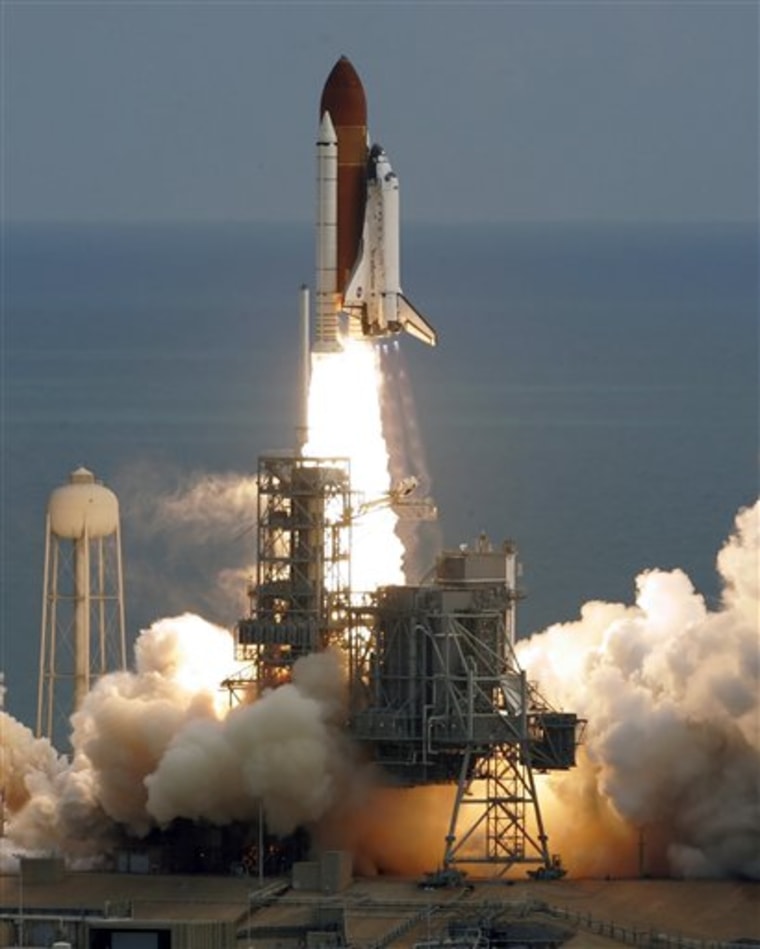Discovery's seven astronauts conducted a painstaking inspection of the space shuttle Wednesday, focusing especially on three wing panels to make sure possible cracks spotted beneath the shuttle's protective coating hadn't worsened.
The inspection came on the first full day of what NASA considers to be the most complicated international space station construction mission yet. The shuttle was to reach the station Thursday.
Commander Pamela Melroy and her crew used a laser and camera-tipped inspection boom to check Discovery's wings and nose. The check is standard since a strike by a slab of fuel-tank foam created a hole in Columbia's wing in 2003, downing the shuttle.
But the astronauts went a little more slowly to capture more detailed images of three of 44 wing panels where it is possible there are cracks beneath the coating. NASA said last week that a new inspection method, conducted before flight, uncovered the possible degradation.
As the inspections were winding down late Wednesday morning, flight director Rick LaBrode said that neither he nor others had spotted any problems of significance. The images will be examined in excruciating detail over the new few days, however, by experts on the ground.
After a lengthy discussion last week, top mission managers deemed Discovery safe for launch even though NASA's own safety group wanted to delay the liftoff to conduct further testing and possibly replace the panels. It is unknown whether cracks could worsen and cause the coating to chip off and make the area more vulnerable to the 3,000-degree (1,649 Celsius) heat of re-entry.
Glitch with modem
During the inspection, the crew also worked to fix a glitch with a high-speed modem that connects the shuttle's computers to Mission Control. LaBrode said if the problem dragged on, the astronauts would simply wait to send digital files — like the extra camera images of the shuttle's wings — from the space station.
At least six pieces of foam insulation came off Discovery's fuel tank during Tuesday's liftoff, but the debris posed no risk to the shuttle because it was shed after the crucial first two minutes, officials said.
A small piece of foam broke off a bracket on Endeavour's fuel tank during the last launch in August, possibly along with ice, and gouged the shuttle's belly. That led to changes to Discovery's fuel tank to prevent dangerous ice buildup.
Engineers will analyze the images gathered during the launch, Wednesday's inspection and photos to be taken Thursday before clearing Discovery for landing.
NASA's space operations chief, Bill Gerstenmaier, said after liftoff that the astronauts face a tremendous series of challenges, but noted, "I can't think of a better start to this mission than what we got today." It was the third on-time shuttle launch in a row.
Five spacewalks planned
The shuttle's primary payload is an Italian-built compartment, about the size of a small bus, that will serve as the docking port for science labs due to arrive beginning in December. Italian astronaut Paolo Nespoli is personally delivering the pressurized chamber, called Harmony.
During their 1 1/2-week station visit, the astronauts must install Harmony, relocate a giant girder and set of solar wings, extend those solar wings and radiators, and test a thermal tile repair kit. Five spacewalks are planned, which will be the most ever conducted while a shuttle is docked at the station.
Astronaut Daniel Tani will move into the station once Discovery docks. He will replace Clayton Anderson, who will return to Earth on the shuttle after five months in space.
